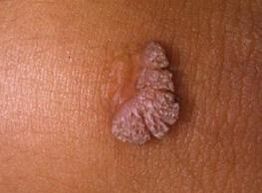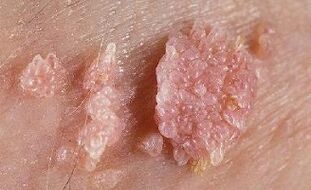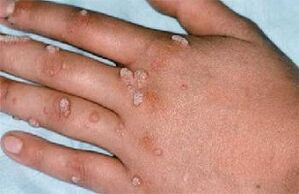
Human papillomavirus (HPV) is a specific human infection belonging to the Papovaviridea family, capable of infecting and transforming epithelial cells.More than a hundred types of HPV have been identified, of which 35 types infect the human urinary tract, causing damage to the integumentary epithelium of the skin and mucous membranes of the genital organs.
Every sixth person is a carrier of the papilloma virus - this is indicated in WHO data.Infections caused by papilloma viruses are warts (condylomas) and belong to the group of viral infectious diseases characterized by the appearance of papillomas on the skin and mucous membranes.HPV is characterized by a chronic form with continuous recurrences.
Reason
Why does human papillomavirus develop and what is it?The causative agent of the disease is a virus that affects the upper layer of the skin and mucous membranes of the genital organs.These viruses can only be transmitted from person to person;Infection occurs through contact with the skin or mucous membranes of a sick person.
Human papillomavirus infection can occur:
- During sex.According to the International Medical Association, papillomavirus is one of the most common sexually transmitted diseases, accounting for more than 60% of cases.
- At birth.The infection can be transmitted from mother to newborn at birth, which then leads to papilloma virus infection or laryngeal papillomatosis.
- With self-injection process.Self-infection can occur if basic hygiene rules are not followed: hair removal or shaving.
- By daily means.Human papilloma virus is highly survivable and can survive for a long time in warm, moist environments in public places such as toilets, bathrooms, gyms and swimming pools.Infection occurs through various skin lesions directly through contact, use of personal hygiene items or in public places.
Different types of HPV cause or are associated with the development of:

- cervical dysplasia (62%);
- pre-invasive and invasive cervical cancer (38%);
- genital and urinary warts (51%);
- 10% of clinically healthy women are HPV carriers;
- In 85% of patients with typical genital warts on the external genitalia, examination will detect additional foci of HPV infection in the vagina and cervix in severe and mild forms.
These data allow us to consider patients with human papillomavirus infection of the genital tract as a group at high risk of developing cervical carcinoma.
Classify
The following classification applies:
- HPV, manifestations of different types of warts (HPV 1-5):
- Warts on the soles of the feet (shaped like callus), these are HPV types 1-4;
- Flat warts are HPV types 3, 10, 28, 49;
- Common warts are HPV type 27.
- The HPV types that affect the vulva, vagina, genitals, cervix, and respiratory tract are HPV types 6, 11, 13, 16, 18, 31, 33, 35.
- HPV, lesions in the form of rashes associated with precancerous conditions (HPVs with a high risk of causing cancer), are HPV 39 and other types.
As you can see, these benign tumors can form on any part of the body:
- neck;
- face;
- under the breast;
- in the armpit;
- on the genitals;
- on the mucous membranes of internal organs, oral cavity and nose.
The need to treat human papillomavirus is due to the following fact.This strain is an intracellular parasite that is unable to reproduce independently.For these purposes, it uses cells of the human body.Viruses can be parasitic for quite a long time, inserting their own DNA into human chromosomes.Its remarkable activation is observed in the context of reduced immunity.
Incubation period
The incubation period is long: from half a month to several years.Human papillomavirus infection is characterized by a hidden (latent) course.A person can be infected with more than one type of papillomavirus at the same time.Under the influence of many different factors, the virus is activated, its reproduction increases, and the disease enters the stage of clinical manifestations.
In most cases (up to 90%), spontaneous recovery occurs within 6-12 months, in other cases there is a long-term chronic relapse with the possibility of malignancy (depending on the type of virus).
Symptoms of human papillomavirus
The human immune system is strong enough to overcome the virus in its early stages of development.And in most cases the disease does not develop.However, over time, months, years or even decades, people may experience some symptoms of HPV infection.
There are several groups of diseases often caused by HPV:
- wartsThey grow round, harder than the body, from 2 mm to 1 cm in diameter.The boundaries of warts are very clearly defined and there are warts that have irregular shapes.They are rough to the touch and can come in many different colors.Usually they form where the skin is most damaged: on the hands, knees or elbows.
- Foot warts.They develop when infected with type 1 and 2 viruses in places where shoes rub or press against the feet.The skin at the site of the wart becomes thicker and the wart does not have clear boundaries.
- Condylomas acuminata– warts especially often appear on the mucous membranes and skin of the genital organs: the head of the penis and foreskin in men, the skin of the labia in women.They can also appear in the bladder, urethra, cervix, vagina, perianal skin, and in the mouth.On the outside, these genital warts look like small protrusions with uneven edges (looks like cauliflower).This disease is caused by human papillomavirus types 6 and 11.
- Bowen's papillomatosis.Small, flat patches of warts (a bit like flat warts) appear around the genitals.It develops more often in men who constantly change sexual partners.Call by type – 16, 18, 31, 33, 42, 48, 51, 54.
Any viral infections that are constantly present in the human body (and HPV is one of them) are activated only when immunity decreases.
Human papillomavirus: photo

To find out what the human papilloma virus looks like with various manifestations, we have prepared a photo.
Symptoms of human papillomavirus in women
Infection can occur in a latent form or can cause the development of genital papillomas.Genital warts are observed mainly in women aged 15 to 30 years.
The main danger of developing disease caused by types 16 and 18 is the development of cervical cancer.Cervical cancer reduces life expectancy by an average of 26 years.From the point of view of cancer development, only viruses that remain in the body for more than a year become dangerous.
Unfortunately, these diseases in women are often asymptomatic until the late stages, when the effectiveness of treatment is significantly reduced.
Symptoms of human papillomavirus in men
For men, human papillomavirus is less dangerous than for women.Usually they are passive carriers of the disease.The likelihood of developing cancer is much lower.
HPV in men can cause genital warts to appear on the foreskin, glans or penile ligaments.Such ingredients must be urgently eliminated, because they affect not only personal hygiene, but also sexual activity.
prevent
We list the main directions for preventing human papillomavirus infection:
- Personal hygiene measures in public places;
- A healthy lifestyle maintains immunity at a high level;
- punctual work and rest hours;
- moderate physical exercise;
- take vitamins, fruits, juices;
- have only one sexual partner (ideally);
- Use condoms when having sex.
There is now a vaccine to prevent human papillomavirus.
Treatment of human papillomavirus
Currently, there is no antiviral medication that can make human papilloma virus disappear from the body.
Different types of interferon and interferonogen can reduce existing tumors, but do not reduce the frequency of new tumors forming.Therefore, the main method for treating human papillomavirus is still the removal of warts by chemical or surgical methods.
Here are the main methods for removing papilloma tissue:
- Radiosurgery.Radiofrequency electrodes remove tumors and coagulate vessels.Then an antiseptic bandage is required.
- Laser beam.Non-contact and bloodless method.At the site of the removed papilloma, a crust remains, under which the healing process will take place.Disadvantages: risk of recurrence, high cost, need to polish remaining scars.
- Electrocoagulation.In terms of effectiveness, results and price, this method is similar to the previous two methods.
- Surgery.This is an operation under local anesthesia.

Before starting treatment, be sure to ask your doctor:
- What treatment methods are available at the clinic where you are being treated?
- How much does each type of treatment cost and what are the possible complications?
- Will surgery be painful?
It must be emphasized that the removal of papillomas should not be considered a complete cure for human papilloma infection, since in this case the person does not cease to be a carrier of the virus, that is, papillary polyps can appear again within a few years.That is why, for preventive purposes, doctors recommend improving the health of the entire body.
frozen
Freezing (burning with liquid nitrogen) is a quick and effective treatment for genital warts.This procedure may be somewhat painful and uncomfortable, but this rarely causes discomfort for the patient.
The freezing of warts is done in multiple sessions over several weeks.Complete removal of warts is observed in 75-80% of patients who have undergone all procedures.
Recommendations for patients
You should not attempt to diagnose and treat human papillomavirus yourself.
- First, you need to choose the right method.
- Second, there is always the risk of confusing genital warts with melanoma.
It's better not to risk it and entrust your health to professionals - this will guarantee you a long and happy sex life.Sexual activity during papillomavirus treatment is stopped until complete recovery.The partner should be examined and treated if necessary.

























